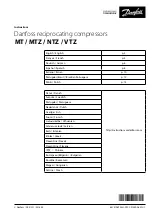
Installation
Moisture obstructs the proper functioning of
the compressor and the refrigeration system. Air
and moisture reduce service life and increase
condensing pressure, and cause excessively high
discharge temperatures, which can destroy the
lubricating properties of the oil. Air and moisture
also increase the risk of acid formation, giving
rise to copper platting. All these phenomena
can cause mechanical and electrical compressor
failure.
For these reasons it’s important to perform a
vacuum dehydration on the system to remove
all residual moisture from the pipe-work after
assembly; PSH compressors are delivered with
<100 ppm moisture level. The required moisture
level in the circuit after vacuum dehydration
must be <100 ppm for systems with a PSH.
• Never use the compressor to evacuate the
system.
• Connect a vacuum pump to both the LP &
HP sides.
• Evacuate the system to a pressure of
500 μm Hg (0.67 mbar) absolute.
Do not use a megohm meter nor apply power to
the compressor while it’s under vacuum as this
may cause internal damage.
Vacuum evacuation and
moisture removal
A properly sized & type of drier is required.
Important selection criteria include the driers
water content capacity, the system refrigeration
capacity and the system refrigerant charge.
The drier must be able to reach and maintain
a moisture level of 50 ppm end point dryness
(EPD).
For new installations with PSH compressors with
polyolester oil, Danfoss recommends using the
Danfoss DML (100% molecular sieve) solid core
filter drier. Molecular sieve filter driers with loose
beads from third party suppliers shall be avoided.
For servicing of existing installations where acid
formation is present the Danfoss DCL (solid core)
filter driers containing activated alumina are
recommended.
The drier is to be oversized rather than under
sized. When selecting a drier, always take into
account its capacity (water content capacity),
the system refrigeration capacity and the system
refrigerant charge.
After burn out, remove & replace the liquid line
filter drier and install a Danfoss type DAS burnout
drier of the appropriate capacity. Refer to the DAS
drier instructions and technical information for
correct use of the burnout drier on the liquid line.
It is recommended to assemble filter drier before
liquid injection pipe in order to avoid debris
blocking liquid injection valve.
Filter driers
For the initial charge the compressor must not
run and eventual service valves must be closed.
Charge refrigerant as close as possible to the
nominal system charge before starting the
compressor.
This initial charging operation must be done in
liquid phase. The best location is on the liquid
line between the condenser outlet and the
filter drier. Then during commissioning, when
needed, a complement of charge can be done
in liquid phase: slowly throttling liquid in on
the low pressure side as far away as possible
from the compressor suction connection while
compressor is running. The refrigerant charge
quantity must be suitable for both summer and
winter operations.
Vacuum or charge from one side can seal the
scrolls and result in a non-starting compressor.
When servicing, always ensure that LP/HP
pressures are balanced before starting the
compressor.
Be sure to follow all government regulations
regarding refrigerant reclamation and storage.
For more detailed information see
“Recommended refrigerant system charging
practice” news bulletin FRCC.EN.050.
Refrigerant charging
34
FRCC.PC.022.A4.02
Application Guidelines











































